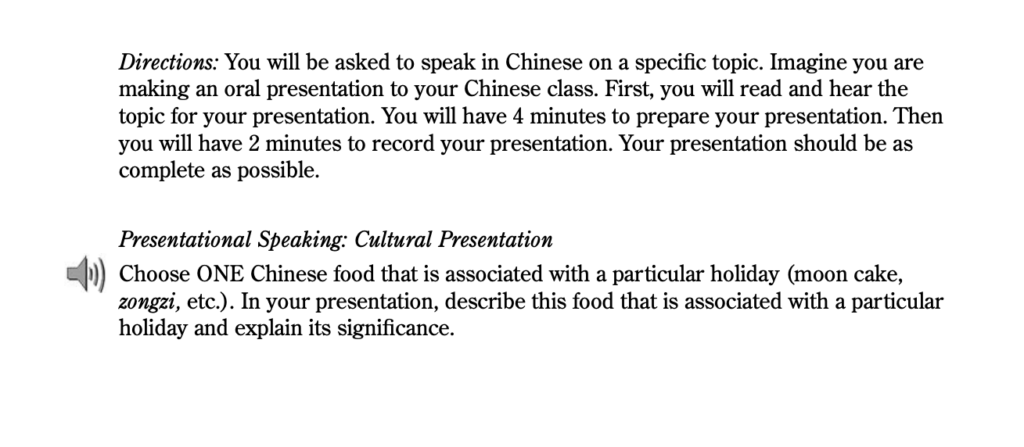Ultimate Guide to the AP Chinese Language and Culture Exam
Of the eight foreign language exams offered by the College Board, the AP Chinese Language and Culture exam is one of the more popular language exams, taken third most frequently after the AP French Language and Culture Exam and the AP Spanish Language and Culture Exam. If you’re planning to take the AP Chinese Language and Culture exam, whether you have taken the AP class, are a native-speaker, or have self-studied, read on for a breakdown of the test and advice on how to best prepare for it. The AP Chinese Language and Culture Exam assesses what the College Board groups into three types of skills: Interpersonal, Interpretive, and Presentation skills. It also assesses a student’s knowledge of Chinese culture. This particular exam has six learning objectives: The AP Chinese Language and Culture exam is approximately two hours and 15 minutes. The exam is split into four separate parts, each of which assess a different skill. Unlike most AP exams, the Chinese Language and Culture exam is administered entirely on a computer. You will read text on the screen, type on a keyboard, listen to recordings through headphones, and speak into a microphone. You won’t have the need to write on paper, although you may use paper to take notes during the exam, which will be collected but not scored. In terms of text display and input, the AP exam computer will offer you options. All text displayed on the screen is available in traditional and simplified form, and you can change between the two if necessary. In addition, students who choose to type with Hanyu Pinyin will have the option to choose between traditional and simplified characters. Take a look at the table below to get an understanding of the four parts that make up the AP Chinese exam, and then some sample questions to familiarize yourself with what to expect. Determine the meaning of a variety of vocabulary and deduce the meaning of unfamiliar words. Decide the meaning of a text based on cultural and/or interdisciplinary information. Infer implied meaning through context. Determine the meaning of a variety of vocabulary and deduce the meaning of unfamiliar words. Decide the meaning of a text based on cultural and/or interdisciplinary information. Infer implied meaning through context. Interpersonal Writing: Read and answer an email message (15 minutes) Presentational Speaking: Deliver a presentation on a given aspect of Chinese culture (choose and describe one Chinese cultural practice or product, and explain its significance) (1 prompt; 7 minutes, preparation time: 4 minutes; response time: 2 minutes) Source: College Board 25-35 Questions | 20 Minutes | 25% of Score Rejoinder questions make up about half of all of Section 1A. These questions assess your ability to use set phrases and social formula, and communication of intent and attitude. Listen to the audio file of this question. The other part of Section 1A are Listening Selection questions, such as the sample question below. These questions assess comprehension and inference. Listen to the following question here. 35-40 Questions | 60 Minutes | 25% of Score In this section, the readings will be in Chinese, and the questions posed will be in English. 2 Questions | 30 Minutes | 25% of Score There will be one question asking you to narrate a story, and another asking you to produce an email response. Section 2B: Free-response Speaking 2 Questions | 11 Minutes | 25% of Score Section 2B has a Conversation question, and a Cultural Presentation question. The former assess spontaneous interpersonal communication skills in Chinese, and the latter directly assesses cultural knowledge and presentational communication skills. Example of a conversation question: Here’s an example of a Presentation question: Takers of the AP Chinese Language and Culture Exam are assessed as two groups: the total group, which is comprised of all test takers; and the standard group, which are students who generally receive most of their foreign language training in U.S. schools, who don’t regularly speak or hear Chinese, and haven’t lived for more than one month in a Chinese-speaking country. In other words, the standard group is those who haven’t had much exposure to the language outside of the classroom. The College Board’s data shows that in 2019, 60% of total test takers scored a 5—the highest AP exam score, but only 16.3% of those in the standard group scored the full 5. The average score for the total group was a 4.19, and for the standard group, a 2.95. This is important to note, since your score will be considered not just against all test takers, but against those with similar levels of exposure to Chinese outside of the classroom. So don’t let the overall scores intimidate you! It’s important to start your studying off with a good understanding of your existing knowledge. Take a practice test to assess your initial knowledge of the material. Although the College Board does not provide a complete practice test, you can find sample questions with scoring explanations included in the course description. Additionally, the multiple-choice questions from the 2007 exam are available online here. You may also find practice or diagnostic exams in many of the commercial study guides. A good place to begin is The College Board’s AP Chinese Language and Culture course description, which covers everything from learning objectives to sample questions. You can find a variety of Chinese texts at multiple comprehension levels available from Chinese Breeze and you can find news stories written for student-level Chinese comprehension at The Chairman’s Bao. You can also prepare for the exam by reviewing the College Board’s Exam Practice Tips and by previewing the exam’s sample audio files. For a more specific idea of where to focus your studying, you may consider using a commercial study guide. Because the AP Chinese Language and Culture course has not been updated in over five years, many study materials are available. Barron’s AP Chinese Language and Culture with MP3 CD, 2nd Edition provides a very comprehensive guide to the exam content including two full-length practice exams with all questions answered and explained, along with an MP3 CD containing exemplary conversations and oral presentations. Barron’s is the top-rated choice for AP Chinese Language and Culture studying, but some reviewers note that it assumes an already advanced-level of Chinese language knowledge and presents much of its content solely in Chinese, including information about Chinese culture. Another solid option is the Strive For a 5: AP Chinese Practice Tests which receives good reviews for the volume of practice material it includes, but some users note that the audio files are difficult to download. Once you have your theory down, test it out by practicing multiple-choice questions. You can find these in most study guides or through online searches. You could also try taking the multiple-choice section of another practice exam. The College Board Course Description includes many practice multiple choice questions along with explanations of their answers. As you go through these, try to keep track of which areas are still tripping you up, and go back over this theory again. Focus on understanding what each question is asking and keep a running list of any vocabulary that is still unfamiliar. You can begin your preparations for the free-response section by brushing up on your vocabulary and grammar. Make sure you have a solid selection of verbs to fall back on in both conversational and formal tones, and practice using them in multiple contexts. Although you won’t officially be scored on your grammar, you’ll still need to be able to communicate effectively, so make sure you can get your point across. Look through The College Board’s past free-response prompts that date back to 2007, with sample responses and scoring commentary. This oral portion of the free-response is perhaps the hardest to prepare for, since it can be difficult to gauge your own speaking abilities. One suggested practice method is to record your own sample answers using the past exam prompts, and then replay them for yourself after you’ve reviewed the scoring criteria. You might also team up with a classmate to compare responses and offer each other some constructive criticism. Another less direct method of preparation is simply to make sure you are hearing and speaking as much Chinese as possible on a daily basis. Once you’ve put some studying in, take another practice test. You should see a steady progression of knowledge you’ve accumulated, and it’s likely that you will see patterns identifying which areas have improved the most and which areas still need improvement. If you have time, repeat each of the steps above to incrementally increase your score. For more about APs, check out these CollegeVine posts: Want to know your odds of acceptance into your dream school? Our data-driven chancing engine will let you know just that, based on your GPA, test scores, extracurriculars, and other factors. We’ll also show you how you stack up against other applicants, and how to improve your chances. Sign up for your free CollegeVine account to discover your chances and gain access to everything you’ll need to make your college applications journey smoother and more successful! What Does the AP Chinese Language and Culture Exam Cover?
How Long is the AP Chinese Language and Culture Exam? What is the Format?
Character display options:
Input methods:
AP Chinese Language and Culture Exam Format
Section
Skill Assessed
Task
# of Questions
Exam weight
1A
Multiple choice listening
Identify the main ideas and supporting details in the audio material.
25-35, 20 minutes
25%
1B
Multiple choice reading
Identify the main ideas and supporting details in the written material.
30-40, 60 minutes
25%
2A
Free response written
Presentational Writing: Narrate a story suggested by a series of pictures (15 minutes)
2, 30 minutes
25%
2B
Free response spoken
Interpersonal Speaking: Respond to a series of thematically linked questions as part of a simulated conversation (4 minutes)
2, 11 minutes
25%
Sample AP Chinese Questions
Section 1A: Multiple Choice Listening


Section 1B: Multiple Choice Reading

Section 2A: Free-response Writing




AP Chinese Language and Culture Exam Score Distribution, Average Score, and Passing Rate
Total Group
Standard Group
Exam Score
N
% At
N
% At
5
8328
60.1
604
16.3
4
2071
14.9
600
16.2
3
2048
14.8
1267
34.3
2
554
4.0
464
12.5
1
852
6.2
763
20.6
# of students
13,853
3,698
Score of 3 or higher
12,447
89.9%
2,471
66.8%
Mean Score
4.19
2.95
Best Ways to Study for the AP Chinese Language and Culture Exam
Step 1: Assess Your Skills
Step 2: Know what to expect
Step 3: Practice Multiple-Choice Questions
Step 4: Practice Free-response Questions
Step 5: Take another practice test





